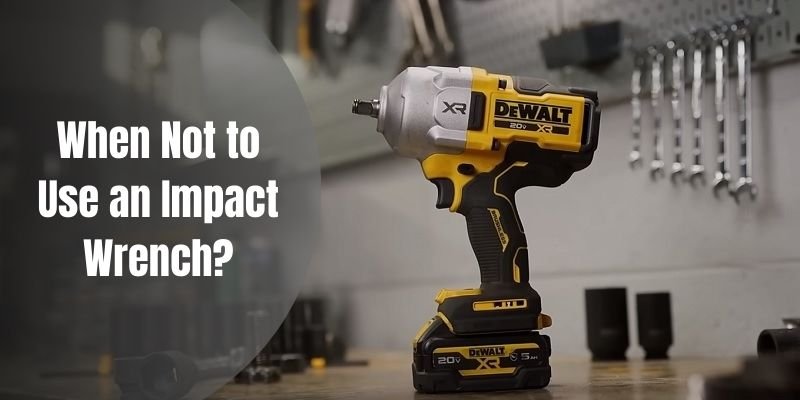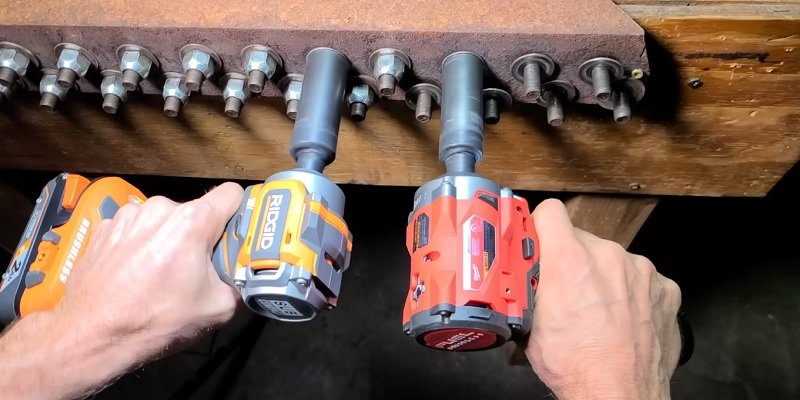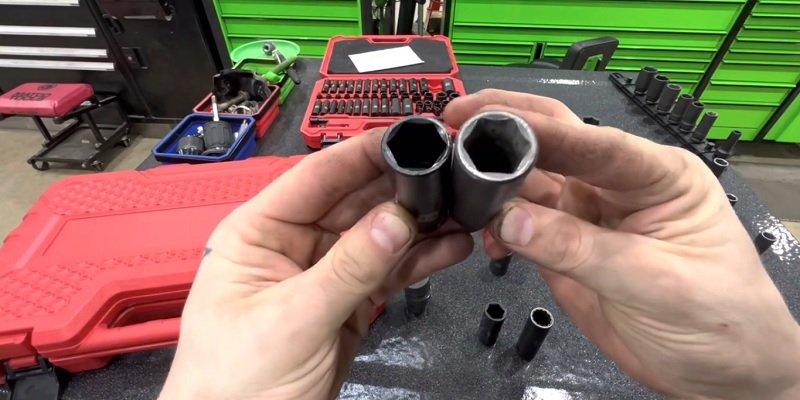Disclosure: This post contains affiliate links and I will be compensated if you make a purchase after clicking through my links. Learn More
An impact wrench should not be used in situations where precise torque control is required, such as when tightening delicate or sensitive materials. When used inappropriately, an impact wrench can cause damage or over-tightening, leading to costly repairs or unsafe conditions.
In industries like electronics, automotive, or aerospace, where accuracy and control are crucial, it is recommended to avoid using an impact wrench and opt for manual tools or torque-controlled devices instead. By carefully selecting the appropriate tools for each task, professionals can ensure the integrity and safety of their work while minimizing risks and avoiding unnecessary expenses.

2 Important Factors: When Not to Use an Impact Wrench
While impact wrenches are powerful tools that can make many tasks easier and faster, it’s important to recognize that there are certain situations where they are not the best option. Understanding the limitations of impact wrenches is essential for both safety and efficiency factors. By using an impact wrench inappropriately, you may risk damaging the equipment, causing injury, or decreasing the overall efficiency of the task at hand.
Safety Factors
When it comes to safety, using an impact wrench in the wrong circumstances can be hazardous. The excessive torque and power of an impact wrench can easily overpower delicate materials or small fasteners, resulting in damage or even injury. It’s crucial to consider the size and strength of the fasteners, as well as the material they are being used on, before deciding to use an impact wrench.
Additionally, working in tight spaces may restrict your movement, making it difficult to control the tool and increasing the chances of accidents. Always prioritize safety and choose the appropriate tool for the task at hand.
Efficiency Factors
Although impact wrenches are known for their speed and efficiency, there are certain scenarios where they may not be the most efficient option. For instance, when dealing with fragile materials or precision-fastening requirements, using an impact wrench might result in overtightening or damage. Delicate components or electronics may require careful hand tightening to avoid any unnecessary force.
Furthermore, in situations where accessibility is limited or the workpiece is in an awkward position, the size and weight of an impact wrench may make it difficult to maneuver effectively. It’s essential to assess the specific requirements of the task and choose the most suitable tool to ensure optimal efficiency.
When To Rely On Hand Tools Instead
While impact wrenches are versatile and powerful tools that can handle a wide range of fastening and loosening tasks, there are certain situations where relying on hand tools is a better choice. In these specific scenarios, the use of hand tools allows for greater precision, control, and a gentler touch. Let’s explore when to opt for hand tools over impact wrenches.
Delicate Or Fragile Materials
Delicate or fragile materials, such as thin plastics, glass, ceramics, or intricate woodwork, require careful handling. Using an impact wrench in these situations can risk causing damage or breaking the material. Hand tools, on the other hand, allow for a more controlled and cautious approach, reducing the risk of unintentional harm. When working with delicate materials, it’s important to choose hand tools that are specifically designed for the task at hand, such as precision screwdrivers, jewelry pliers, or delicate chisels.
Low Torque Requirements
Not every task requires the high torque power that an impact wrench can deliver. When dealing with low torque requirements, such as assembling furniture or working on small household repairs, hand tools can provide ample strength and precision without the need for the additional power and weight of an impact wrench. Screwdrivers, wrenches, and pliers are common hand tools that are perfectly suited for these lower torque tasks.
Precision And Control
When it comes to jobs that demand a high level of precision and control, relying on hand tools is the way to go. Impact wrenches are excellent for generating fast and efficient results, but they may lack the finesse needed for tasks such as intricate metalwork, fine carpentry, or electrical work. Hand tools give you the tactile feedback and control necessary to carefully maneuver in tight spaces, accurately measure, align, and make minute adjustments. Consider hand tools like calipers, precision knives, or needle-nose pliers when precision and control are paramount.
Situations Where Impact Wrenches Are Not Suitable
When it comes to power tools, impact wrenches are often a go-to for many projects. Their ability to deliver high torque and make quick work of stubborn fasteners is unparalleled. However, there are certain situations where impact wrenches are not suitable and can even cause more harm than good.
In this section, we will explore the various scenarios where using an impact wrench may not be the best option.
Working On Small Fasteners
Impact wrenches are known for their power, which makes them ideal for handling large bolts and heavy-duty applications. However, when it comes to smaller fasteners such as screws, nuts, or delicate components, the excessive torque generated by an impact wrench can easily lead to over-tightening and potential damage. It is best to rely on manual hand tools like screwdrivers or wrenches to ensure precision and avoid any mishaps.
Tight Or Confined Spaces
In tight or confined spaces, using an impact wrench can be challenging and ineffective. The bulky nature of the tool, along with its long body and large socket, may not allow for sufficient maneuverability. This can result in difficulty reaching and properly aligning the fasteners. In such cases, opting for a compact hand tool that offers better accessibility, control, and flexibility would be a smarter choice.
Applications Requiring Precision
When it comes to tasks that demand precision, such as delicate machinery assembly or fine carpentry, an impact wrench is not the right tool to use. The high torque produced by an impact wrench can easily overpower delicate components, leading to cracks, fractures, or misalignments. In situations where accuracy and finesse are paramount, it is advisable to use hand tools that provide better control and allow for gradual tightening or adjustment.
Dealing With Soft Or Brittle Materials
Soft or brittle materials like plastic, ceramics, or glass require a delicate touch to avoid damage. The strong rotational force of an impact wrench can easily strip threads, crack or shatter these materials. It is important to note that impact wrenches are mainly designed for heavy-duty applications on metal surfaces. To work with soft or brittle materials, hand tools or low-torque power tools should be used to ensure safety and prevent any costly mishaps.
Working With Non-threaded Fasteners
An impact wrench is specifically designed for threaded fasteners and may not provide the necessary grip or control when dealing with non-threaded fasteners such as pins, rivets, or clips. Attempting to use an impact wrench on non-threaded fasteners may result in damage, misalignment, or even launch the fasteners at high speeds, posing a safety risk. In these situations, alternate tools like pliers or specific tools designed for non-threaded fasteners should be used.
Expert Tips For Maximizing Impact Wrench Benefits
When it comes to using an impact wrench, knowing when to utilize this powerful tool can be just as important as knowing when not to use it. While an impact wrench can greatly speed up various tasks and increase productivity, there are certain instances where it may not be the best tool for the job.
In this section, we will discuss expert tips for maximizing the benefits of an impact wrench, so you can make more informed decisions and achieve optimal results.
Proper Torque Settings And Techniques
One of the key factors in using an impact wrench effectively is ensuring proper torque settings and techniques. Impact wrenches are designed to apply torque to fasteners, allowing for quick and efficient tightening or loosening. However, using excessive torque or using improper techniques can result in damage or stripped threads. To avoid such issues, it’s important to:
Set the torque correctly: Always refer to the manufacturer’s specifications for the recommended torque settings. Adjust the torque accordingly to ensure the fasteners are tightened securely without being over-torqued.
Use the correct techniques: When using an impact wrench, it’s crucial to apply consistent pressure and gradually tighten or loosen the fastener. Avoid abruptly stopping the tool or jerking motions, as they can lead to unintended consequences.
Assessing The Job Requirements
Before reaching for your impact wrench, take a moment to assess the specific job requirements. Not every task is suitable for an impact wrench, and using the wrong tool can result in damage or inefficiency. Consider the following:
Material and Size: Impact wrenches are generally better suited for heavy-duty applications and larger fasteners. Assess if the material and size of the fasteners are appropriate for an impact wrench, or if a different tool may be more suitable for the task.
Torque Control: Some applications require more precise torque control than an impact wrench can provide. In such cases, it may be necessary to opt for a different torque wrench or a manual approach.
Choosing The Right Impact Wrench For The Task
Not all impact wrenches are created equal, and choosing the right one for the task at hand can greatly impact the outcome. Consider the following factors when selecting an impact wrench:
Torque Range: Ensure the impact wrench has a torque range that encompasses the specific torque requirements of the job.
Control Features: Look for impact wrenches with adjustable power settings and variable speed controls. These features allow for greater control and versatility in different applications.
Size and Weight: Depending on the task, the size and weight of the impact wrench can play a role in its maneuverability and ease of use. Consider your comfort and the accessibility of the work area.
By following these expert tips, you can maximize the benefits of using an impact wrench while ensuring efficient and safe operations. Remember to always prioritize safety and ensure proper usage and maintenance of your tools. With the right approach, an impact wrench can be a true asset in your toolbox.
Frequently Asked Questions For When Not To Use An Impact Wrench?
Is It Bad To Use An Impact Wrench To Remove Lug Nuts?
Using an impact wrench to remove lug nuts is not bad. It provides a quick and efficient way to loosen and tighten them. However, you should use it responsibly and not overtighten the nuts, as it can damage the threads or studs.
Use proper torque specifications to avoid any issues.
When Should You Use An Impact Wrench?
An impact wrench should be used when you need to quickly and effortlessly tighten or loosen bolts or nuts. It is perfect for heavy-duty tasks like automotive repairs, construction projects, and assembling furniture. The powerful rotational force of an impact wrench saves time and effort compared to manual tools.
When Not To Use An Impact Driver On A Car?
Avoid using an impact driver on a car when removing delicate or sensitive parts, such as plastic trim or electrical components. Additionally, refrain from using it on tight or inaccessible areas where excessive force may cause damage. It’s best to use hand tools in these situations to ensure precision and prevent potential harm to your vehicle.
What Are The Hazards Of Impact Wrenches?
Impact wrenches can pose hazards such as hand-arm vibration syndrome and hearing damage due to high noise levels. The intense force can also cause fasteners to break or strip threads. To prevent accidents, it’s important to use the appropriate safety equipment and follow proper operating procedures.
Final Thoughts
In certain situations, using an impact wrench may not be the best choice. Remember, it’s crucial to consider factors such as delicate materials, tight spaces, and precision requirements. By understanding when not to use an impact wrench, you can ensure safety, avoid costly damages, and maintain efficiency.
By finding the right tool for the job, you’ll be able to handle various tasks with ease and effectiveness.


